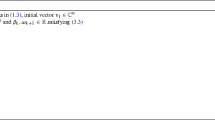Abstract
The Golub–Kahan–Lanczos (GKL) bidiagonal reduction generates, by recurrence, the matrix factorization of \(X \in \mathbb{R }^{m \times n}, m \ge n\), given by
where \(U \in \mathbb{R }^{m \times n}\) is left orthogonal, \(V \in \mathbb{R }^{n \times n}\) is orthogonal, and \(B \in \mathbb{R }^{n \times n}\) is bidiagonal. When the GKL recurrence is implemented in finite precision arithmetic, the columns of \(U\) and \(V\) tend to lose orthogonality, making a reorthogonalization strategy necessary to preserve convergence of the singular values. The use of an approach started by Simon and Zha (SIAM J Sci Stat Comput, 21:2257–2274, 2000) that reorthogonalizes only one of the two left orthogonal matrices \(U\) and \(V\) is shown to be very effective by the results presented here. Supposing that \(V\) is the matrix reorthogonalized, the reorthogonalized GKL algorithm proposed here is modeled as the Householder Q–R factorization of \(\left( \begin{array}{c} 0_{n \times k} \\ X V_k \end{array}\right) \) where \(V_k = V(:,1:k)\). That model is used to show that if \(\varepsilon _M \) is the machine unit and
where \(\mathbf{tril }(\cdot )\) is the strictly lower triangular part of the contents, then: (1) the GKL recurrence produces Krylov spaces generated by a nearby matrix \(X + \delta X\), \(\Vert \delta X\Vert _F = \mathcal O (\varepsilon _M + \bar{\eta }) \Vert X\Vert _F\); (2) singular values converge in the Lanczos process at the rate expected from the GKL algorithm in exact arithmetic on a nearby matrix; (3) a new proposed algorithm for recovering leading left singular vectors produces better bounds on loss of orthogonality and residual errors.

Similar content being viewed by others
References
Arioli, M.: Generalized Golub–Kahan bidiagonal reduction and stopping criteria. Technical Report RAL-TR-2010-08, Rutherford Appleton Laboratory, Didcot (2010)
Barlow, J.L., Bosner, N., Drmač, Z.: A new backward stable bidiagonal reduction method. Linear Algebra Appl. 397, 35–84 (2005)
Barlow, J.L., Smoktunowicz, A., Erbay, H.: Improved Gram–Schmidt downdating methods. BIT 45, 259–285 (2005)
Benbow, S.J.: Solving generalized least squares problems with LSQR. SIAM J. Matrix Anal. Appl. 21(1), 166–177 (1999)
Berry, M., Drmač, Z., Jessup, E.: Matrices, vector spaces, and information retrieval. SIAM Rev. 41, 335–362 (1999)
Björck, Å.: A bidiagonalization algorithm for solving large and sparse ill-posed systems of linear equations. BIT 28, 659–670 (1988)
Björck, Å., Paige, C.C.: Loss and recapture of orthogonality in the modified Gram–Schmidt algorithm. SIAM J. Matrix Anal. Appl. 13, 176–190 (1992)
Bosner, N., Barlow, J.: Block and parallel versions of one-sided bidiagonalization. SIAM J. Matrix Anal. Appl. 29(3), 927–953 (2007)
Calvetti, D., Reichel, L.: Tikhanov regularization on large linear problems. BIT 43, 263–283 (2003)
Daniel, J.W., Gragg, W.B., Kaufman, L., Stewart, G.W.: Reorthogonalization and stable algorithms for updating the Gram–Schmidt QR factorization. Math. Comput. 30(136), 772–795 (1976)
Eldén, L.: Algorithms for the regularization of ill-conditioned least squares problems. BIT 17, 134–145 (1977)
Golub, G.H., Kahan, W.M.: Calculating the singular values and pseudoinverse of a matrix. SIAM J. Numer. Anal. Ser. B 2, 205–224 (1965)
Golub, G.H., Van Loan, C.F.: Matrix Computations, 3rd edn. The Johns Hopkins Press, Baltimore (1996)
Higham, N.J.: Accuracy and Stability of Numerical Algorithms, 2nd edn. SIAM Publications, Philadelphia (2002)
Higham, N.J.: Functions of Matrices: Theory and Computation. SIAM Publications, Philadelphia (2008)
Hnetynkova, I., Plesinger, M., Strakos, Z.: The regularizing effect of Golub–Kahan iterative bidiagonalization and revealing the noise level in the data. BIT 49, 669–696 (2009)
Mazumber, R., Hastie, T., Tishbarani, R.: Spectral regularization algorithms for learning large incomplete matrices. http://www-stat.stanford.edu/hastie/Papers/SVD_JMLR.pdf
Paige, C.C., Saunders, M.A.: LSQR: an algorithm for sparse linear equations and least squares problems. ACM Trans. Math. Softw. 8, 43–71 (1982)
Paige, C.C.: The Computation of Eigenvalues and Eigenvectors of Very Large Sparse Matrices. PhD thesis, University of London, London (1971)
Paige, C.C.: A useful form of unitary matrix from any sequence of unit 2-norm \(n\)-vectors. SIAM J. Matrix Anal. Appl. 31(2), 565–583 (2009)
Paige, C.C., Saunders, M.A.: Algorithm 583 LSQR: sparse linear equations and least squares problems. ACM Trans. Math. Softw. 8, 195–209 (1982)
Parlett, B.N.: The Symmetric Eigenvalue Problem. SIAM Publications, Philadelphia (1998) Republication of 1980 book.
Parlett, B.N., Scott, D.S.: The Lanczos algorithm with selective reorthogonalization. Math. Comput. 33, 217–238 (1979)
Simon, H., Zha, H.: Low rank matrix approximation using the Lanczos bidiagonalization process. SIAM J. Sci. Stat. Comput. 21, 2257–2274 (2000)
Yoo, K., Park, H.: Accurate downdating of a modified Gram–Schmidt QR decomposition. BIT 36, 166–181 (1996)
Acknowledgments
The author thanks Lothar Reichel and the referees for their helpful suggestions.
Author information
Authors and Affiliations
Corresponding author
Additional information
The research of Jesse L. Barlow was supported by the National Science Foundation under Grant No. CCF-0429481 and CCF-1115704.
Appendix: Proof of bound on \(\Vert \mathbf{r }_k\Vert _2\)
Appendix: Proof of bound on \(\Vert \mathbf{r }_k\Vert _2\)
Proof of Lemma 3.1
We have that, in floating point arithmetic,
where
We note that from (4.39) and (4.40), we have
and thus (using the convention that \(\phi _1 =0\)),
Therefore, since \(\varepsilon _M \bar{\eta }_k = \mathcal O (\varepsilon _M ^2 + \bar{\eta }_k^2)\)
Thus
\(\square \)
Rights and permissions
About this article
Cite this article
Barlow, J.L. Reorthogonalization for the Golub–Kahan–Lanczos bidiagonal reduction. Numer. Math. 124, 237–278 (2013). https://doi.org/10.1007/s00211-013-0518-8
Received:
Revised:
Published:
Issue Date:
DOI: https://doi.org/10.1007/s00211-013-0518-8




